2015 NISSAN MICRA power steering
[x] Cancel search: power steeringPage 165 of 293
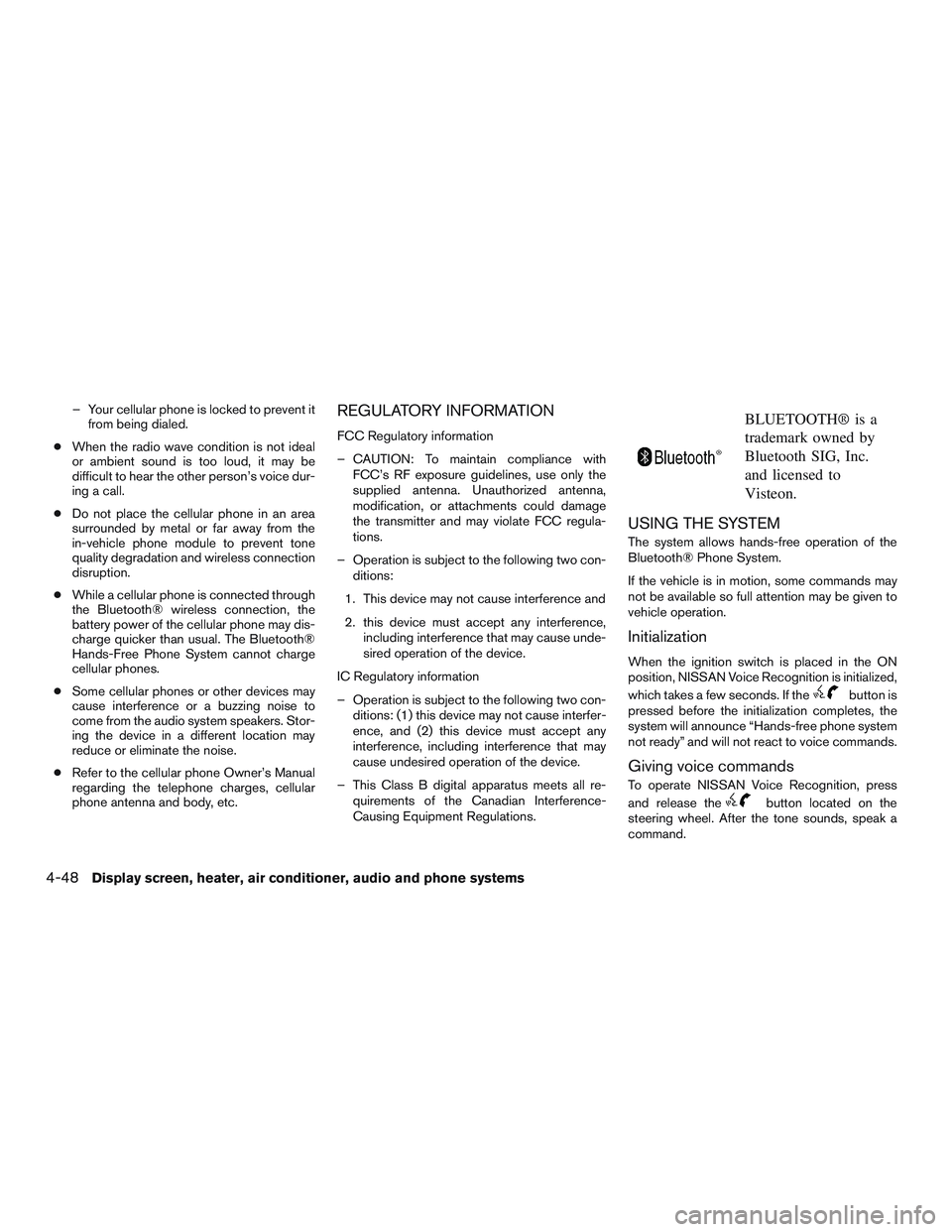
– Your cellular phone is locked to prevent itfrom being dialed.
● When the radio wave condition is not ideal
or ambient sound is too loud, it may be
difficult to hear the other person’s voice dur-
ing a call.
● Do not place the cellular phone in an area
surrounded by metal or far away from the
in-vehicle phone module to prevent tone
quality degradation and wireless connection
disruption.
● While a cellular phone is connected through
the Bluetooth® wireless connection, the
battery power of the cellular phone may dis-
charge quicker than usual. The Bluetooth®
Hands-Free Phone System cannot charge
cellular phones.
● Some cellular phones or other devices may
cause interference or a buzzing noise to
come from the audio system speakers. Stor-
ing the device in a different location may
reduce or eliminate the noise.
● Refer to the cellular phone Owner’s Manual
regarding the telephone charges, cellular
phone antenna and body, etc.REGULATORY INFORMATION
FCC Regulatory information
– CAUTION: To maintain compliance with
FCC’s RF exposure guidelines, use only the
supplied antenna. Unauthorized antenna,
modification, or attachments could damage
the transmitter and may violate FCC regula-
tions.
– Operation is subject to the following two con- ditions:
1. This device may not cause interference and
2. this device must accept any interference, including interference that may cause unde-
sired operation of the device.
IC Regulatory information
– Operation is subject to the following two con- ditions: (1) this device may not cause interfer-
ence, and (2) this device must accept any
interference, including interference that may
cause undesired operation of the device.
– This Class B digital apparatus meets all re- quirements of the Canadian Interference-
Causing Equipment Regulations.
BLUETOOTH® is a
trademark owned by
Bluetooth SIG, Inc.
and licensed to
Visteon.
USING THE SYSTEM
The system allows hands-free operation of the
Bluetooth® Phone System.
If the vehicle is in motion, some commands may
not be available so full attention may be given to
vehicle operation.
Initialization
When the ignition switch is placed in the ON
position, NISSAN Voice Recognition is initialized,
which takes a few seconds. If the
button is
pressed before the initialization completes, the
system will announce “Hands-free phone system
not ready” and will not react to voice commands.
Giving voice commands
To operate NISSAN Voice Recognition, press
and release the
button located on the
steering wheel. After the tone sounds, speak a
command.
4-48Display screen, heater, air conditioner, audio and phone systems
Page 174 of 293
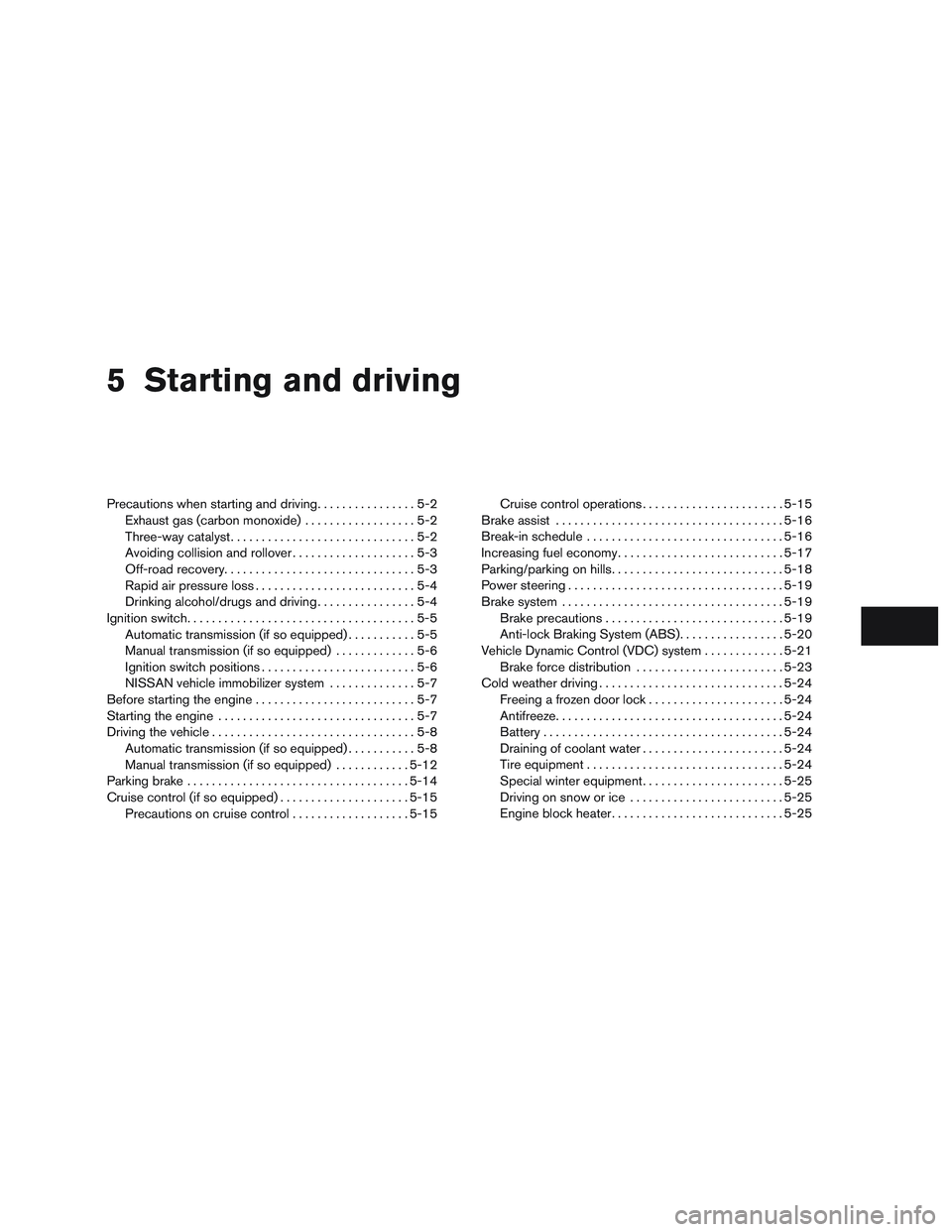
5 Starting and driving
Precautions when starting and driving................5-2
Exhaust gas (carbon monoxide) ..................5-2
Three-way catalyst ..............................5-2
Avoiding collision and rollover . . ..................5-3
Off-road recovery ...............................5-3
Rapid air pressure loss ..........................5-4
Drinking alcohol/drugs and driving ................5-4
Ignition switch .....................................5-5
Automatic transmission (if so equipped) ...........5-5
Manual transmission (if so equipped) .............5-6
Ignition switch positions .........................5-6
NISSAN vehicle immobilizer system ..............5-7
Before starting the engine ..........................5-7
Starting the engine ................................5-7
Driving the vehicle .................................5-8
Automatic transmission (if so equipped) ...........5-8
Manual transmission (if so equipped) ............5-12
Parking brake .................................... 5-14
Cruise control (if so equipped) .....................5-15
Precautions on cruise control . . .................5-15Cruise control operations
.......................5-15
Brake assist ..................................... 5-16
Break-in schedule ................................ 5-16
Increasing fuel economy ........................... 5-17
Parking/parking on hills ............................ 5-18
Power steering ................................... 5-19
Brake system .................................... 5-19
Brake precautions ............................. 5-19
Anti-lock Braking System (ABS) .................5-20
Vehicle Dynamic Control (VDC) system .............5-21
Brake force distribution ........................ 5-23
Cold weather driving .............................. 5-24
Freeing a frozen door lock ......................5-24
Antifreeze ..................................... 5-24
Battery ....................................... 5-24
Draining of coolant water .......................5-24
Tire equipment ................................ 5-24
Special winter equipment .......................5-25
Driving on snow or ice ......................... 5-25
Engine block heater ............................ 5-25
Page 192 of 293
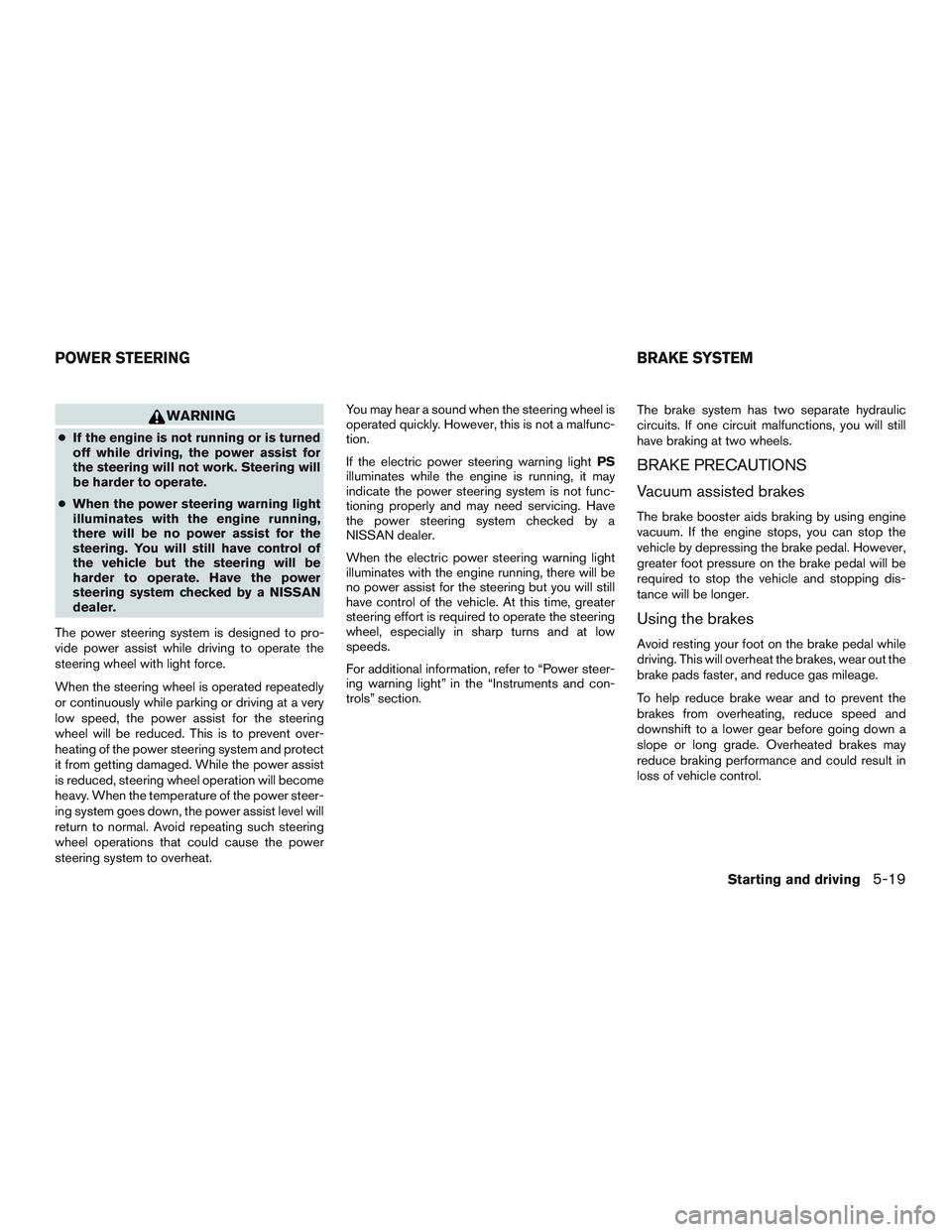
WARNING
●If the engine is not running or is turned
off while driving, the power assist for
the steering will not work. Steering will
be harder to operate.
● When the power steering warning light
illuminates with the engine running,
there will be no power assist for the
steering. You will still have control of
the vehicle but the steering will be
harder to operate. Have the power
steering system checked by a NISSAN
dealer.
The power steering system is designed to pro-
vide power assist while driving to operate the
steering wheel with light force.
When the steering wheel is operated repeatedly
or continuously while parking or driving at a very
low speed, the power assist for the steering
wheel will be reduced. This is to prevent over-
heating of the power steering system and protect
it from getting damaged. While the power assist
is reduced, steering wheel operation will become
heavy. When the temperature of the power steer-
ing system goes down, the power assist level will
return to normal. Avoid repeating such steering
wheel operations that could cause the power
steering system to overheat. You may hear a sound when the steering wheel is
operated quickly. However, this is not a malfunc-
tion.
If the electric power steering warning light
PS
illuminates while the engine is running, it may
indicate the power steering system is not func-
tioning properly and may need servicing. Have
the power steering system checked by a
NISSAN dealer.
When the electric power steering warning light
illuminates with the engine running, there will be
no power assist for the steering but you will still
have control of the vehicle. At this time, greater
steering effort is required to operate the steering
wheel, especially in sharp turns and at low
speeds.
For additional information, refer to “Power steer-
ing warning light” in the “Instruments and con-
trols” section. The brake system has two separate hydraulic
circuits. If one circuit malfunctions, you will still
have braking at two wheels.
BRAKE PRECAUTIONS
Vacuum assisted brakes
The brake booster aids braking by using engine
vacuum. If the engine stops, you can stop the
vehicle by depressing the brake pedal. However,
greater foot pressure on the brake pedal will be
required to stop the vehicle and stopping dis-
tance will be longer.
Using the brakes
Avoid resting your foot on the brake pedal while
driving. This will overheat the brakes, wear out the
brake pads faster, and reduce gas mileage.
To help reduce brake wear and to prevent the
brakes from overheating, reduce speed and
downshift to a lower gear before going down a
slope or long grade. Overheated brakes may
reduce braking performance and could result in
loss of vehicle control.
POWER STEERING
BRAKE SYSTEM
Starting and driving5-19
Page 193 of 293
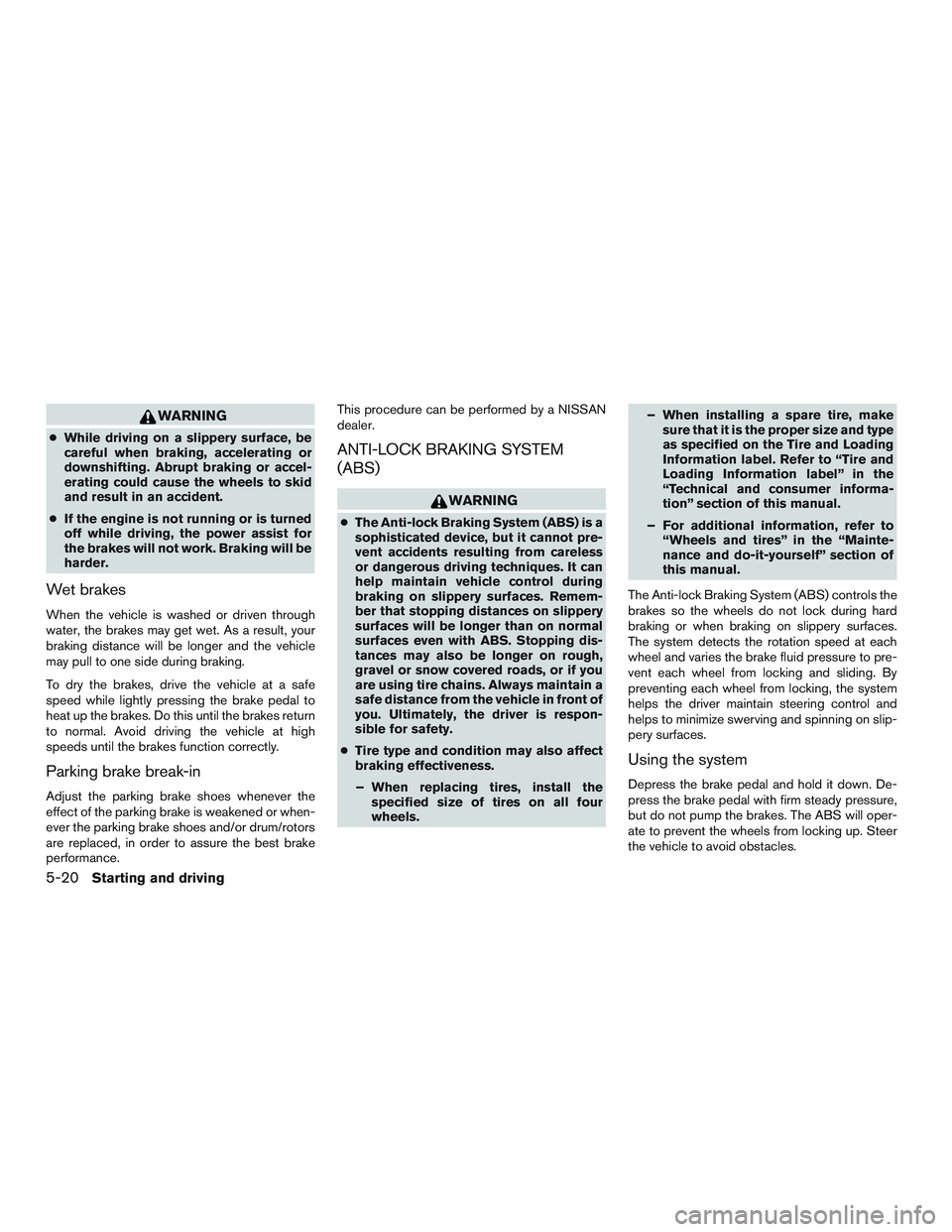
WARNING
●While driving on a slippery surface, be
careful when braking, accelerating or
downshifting. Abrupt braking or accel-
erating could cause the wheels to skid
and result in an accident.
● If the engine is not running or is turned
off while driving, the power assist for
the brakes will not work. Braking will be
harder.
Wet brakes
When the vehicle is washed or driven through
water, the brakes may get wet. As a result, your
braking distance will be longer and the vehicle
may pull to one side during braking.
To dry the brakes, drive the vehicle at a safe
speed while lightly pressing the brake pedal to
heat up the brakes. Do this until the brakes return
to normal. Avoid driving the vehicle at high
speeds until the brakes function correctly.
Parking brake break-in
Adjust the parking brake shoes whenever the
effect of the parking brake is weakened or when-
ever the parking brake shoes and/or drum/rotors
are replaced, in order to assure the best brake
performance. This procedure can be performed by a NISSAN
dealer.
ANTI-LOCK BRAKING SYSTEM
(ABS)
WARNING
●
The Anti-lock Braking System (ABS) is a
sophisticated device, but it cannot pre-
vent accidents resulting from careless
or dangerous driving techniques. It can
help maintain vehicle control during
braking on slippery surfaces. Remem-
ber that stopping distances on slippery
surfaces will be longer than on normal
surfaces even with ABS. Stopping dis-
tances may also be longer on rough,
gravel or snow covered roads, or if you
are using tire chains. Always maintain a
safe distance from the vehicle in front of
you. Ultimately, the driver is respon-
sible for safety.
● Tire type and condition may also affect
braking effectiveness.
– When replacing tires, install the specified size of tires on all four
wheels. – When installing a spare tire, make
sure that it is the proper size and type
as specified on the Tire and Loading
Information label. Refer to “Tire and
Loading Information label” in the
“Technical and consumer informa-
tion” section of this manual.
– For additional information, refer to “Wheels and tires” in the “Mainte-
nance and do-it-yourself” section of
this manual.
The Anti-lock Braking System (ABS) controls the
brakes so the wheels do not lock during hard
braking or when braking on slippery surfaces.
The system detects the rotation speed at each
wheel and varies the brake fluid pressure to pre-
vent each wheel from locking and sliding. By
preventing each wheel from locking, the system
helps the driver maintain steering control and
helps to minimize swerving and spinning on slip-
pery surfaces.
Using the system
Depress the brake pedal and hold it down. De-
press the brake pedal with firm steady pressure,
but do not pump the brakes. The ABS will oper-
ate to prevent the wheels from locking up. Steer
the vehicle to avoid obstacles.
5-20Starting and driving
Page 212 of 293
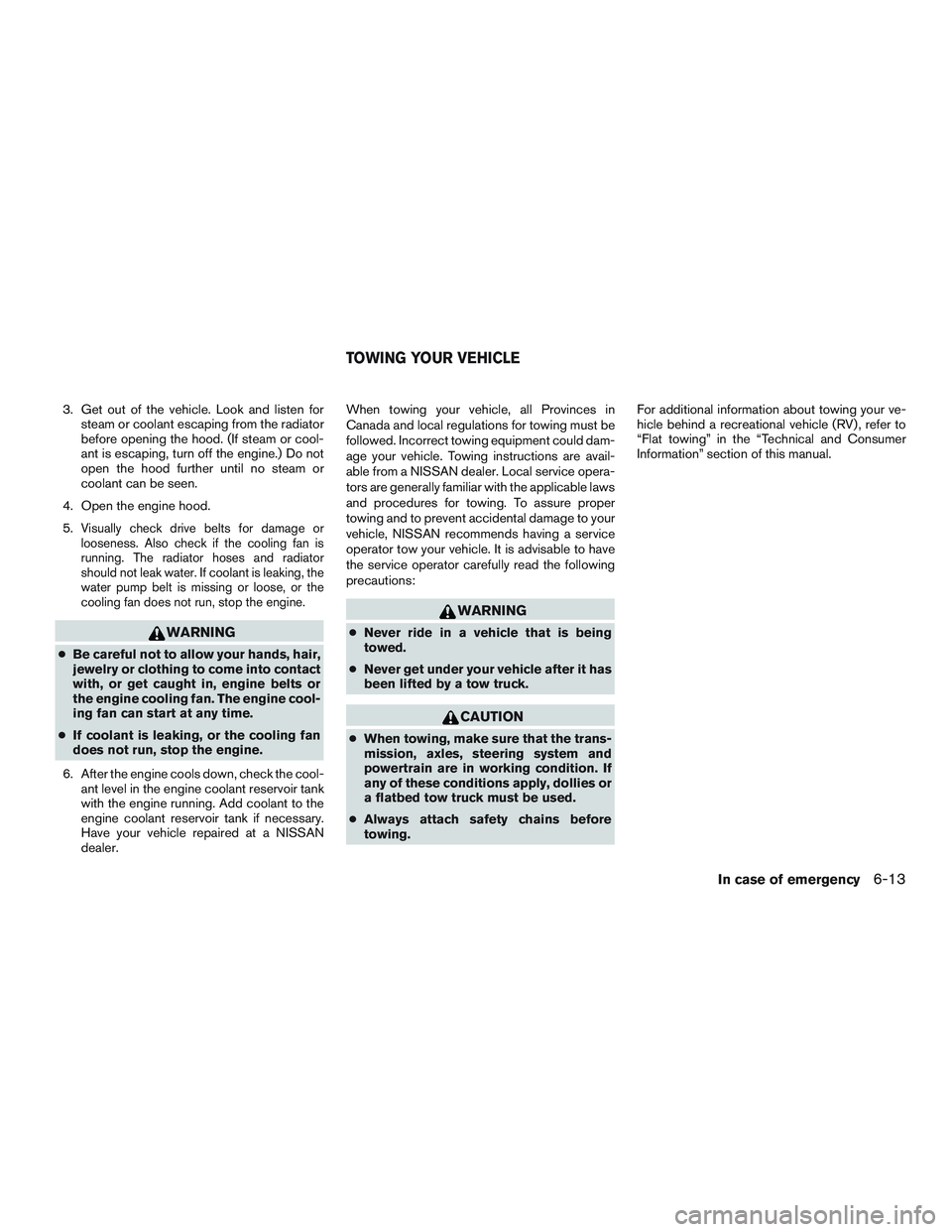
3. Get out of the vehicle. Look and listen forsteam or coolant escaping from the radiator
before opening the hood. (If steam or cool-
ant is escaping, turn off the engine.) Do not
open the hood further until no steam or
coolant can be seen.
4. Open the engine hood.
5.
Visually check drive belts for damage or
looseness. Also check if the cooling fan is
running. The radiator hoses and radiator
should not leak water. If coolant is leaking, the
water pump belt is missing or loose, or the
cooling fan does not run, stop the engine.
WARNING
● Be careful not to allow your hands, hair,
jewelry or clothing to come into contact
with, or get caught in, engine belts or
the engine cooling fan. The engine cool-
ing fan can start at any time.
● If coolant is leaking, or the cooling fan
does not run, stop the engine.
6. After the engine cools down, check the cool- ant level in the engine coolant reservoir tank
with the engine running. Add coolant to the
engine coolant reservoir tank if necessary.
Have your vehicle repaired at a NISSAN
dealer. When towing your vehicle, all Provinces in
Canada and local regulations for towing must be
followed. Incorrect towing equipment could dam-
age your vehicle. Towing instructions are avail-
able from a NISSAN dealer. Local service opera-
tors are generally familiar with the applicable laws
and procedures for towing. To assure proper
towing and to prevent accidental damage to your
vehicle, NISSAN recommends having a service
operator tow your vehicle. It is advisable to have
the service operator carefully read the following
precautions:
WARNING
●
Never ride in a vehicle that is being
towed.
● Never get under your vehicle after it has
been lifted by a tow truck.
CAUTION
● When towing, make sure that the trans-
mission, axles, steering system and
powertrain are in working condition. If
any of these conditions apply, dollies or
a flatbed tow truck must be used.
● Always attach safety chains before
towing. For additional information about towing your ve-
hicle behind a recreational vehicle (RV) , refer to
“Flat towing” in the “Technical and Consumer
Information” section of this manual.
TOWING YOUR VEHICLE
In case of emergency6-13
Page 289 of 293

Fuel-filler door lock opener lever......3-11
Power door locks ...............3-4
Lowfuelwarninglight...............2-9
Low windshield-washer fluid warning light . . .2-9
Luggage (See vehicle loading information) . .9-13
M
Maintenance Generalmaintenance.............8-2
Insidethevehicle...............8-3
Maintenanceprecautions...........8-5
Outsidethevehicle..............8-2
Seat belt maintenance ............1-16
Under the hood and vehicle .........8-4
Maintenance requirements ............8-2
Malfunctionindicatorlight............2-11
Manual front seat adjustment ...........1-2
Manual windows .................2-26
Map pocket ....................2-21
Meters and gauges ................2-3
Instrument brightness control ........2-18
Mirror Inside mirror .................3-14
Outside mirror control ............3-15
Outside mirrors ...............3-15
Vanity mirror .................3-14
Mirrors ......................3-14
Multi-remote control system
(See remote keyless entry system) ........3-6 N
NISSAN vehicle immobilizer
system .................2-13,3-2,5-7
O
Octane rating (See fuel octane rating) ......9-5
Odometer .....................2-4
Oil Capacities and recommended
fuel/lubricants .................9-2
Changingengineoil.............8-10
Changing engine oil filter ..........8-11
Checking engine oil level ...........8-9
Engineoil ...................8-9
Engine oil and oil filter recommendation . . .9-6
Engine oil viscosity ..............9-6
Oneshotcall...................4-49
Outside mirror control ..............3-15
Outside mirrors .................3-15
Overdrive switch .................5-12
Overheat If your vehicle overheats ...........6-12
Owner’s manual order form ...........9-20
Owner’s manual/service manual order
information ....................9-20
P
Parking Parking brake operation ...........5-14
Parking/parking on hills ...........5-18
Phone, Bluetooth® hands-free system .....4-46Power
Power door locks ...............3-4
Poweroutlet.................2-21
Power rear windows .............2-26
Power steering system ...........5-19
Power windows ...............2-24
Rear power windows ............2-26
Poweroutlet...................2-21
Power steering ..................5-19
Precautions Maintenance precautions ...........8-5
Precautions on booster
seats...........1-18,1-25,1-31,1-36
Precautions on child
restraints .........1-18,1-25,1-31,1-36
Precautionsonseatbeltusage.......1-10
Precautions on supplemental restraint
system ....................1-40
Precautions when starting and driving ....5-2
Push starting ...................6-12
R
Radio CarphoneorCBradio ...........4-45
FM-AM
radio with compact disc (CD)
player.....................4-31
FM/AM/SAT radio with compact disc (CD)
player.....................4-35
Steering wheel audio control switch ....4-44
Readiness for inspection maintenance (I/M)
test........................9-19
Rear power windows ..............2-26
Rearseat......................1-4
RearView Monitor ..............4-2,4-3
10-4
Page 290 of 293

Rear window defroster switch.........2-16
Rear window wiper and washer switches . . .2-16
Recorders Eventdata..................9-19
Refrigerant recommendation ...........9-7
Registering your vehicle in another country . .9-10
Remote keyless entry system ...........3-6
Reporting safety defects (US only) .......9-18
S
Safety Child safety rear door lock ..........3-5
Childseatbelts.....1-18,1-25,1-31,1-36
Reporting safety defects (US only) .....9-18
Seat adjustment Front manual seat adjustment ........1-2
Rear seat adjustment .............1-4
Seat belt Child safety ..................1-16
Infantsandsmallchildren..........1-17
InjuredPerson................1-12
Largerchildren................1-17
Precautionsonseatbeltusage.......1-10
Pregnant women ...............1-12
Seat belt extenders .............1-15
Seat belt maintenance ............1-16
Seat belts ...................1-10
Shoulder belt height adjustment ......1-15
Three-point type with retractor .......1-12
Seat belt extenders ...............1-15
Seatbeltwarninglight ..............2-9
Seats Adjustment ...................1-2
Frontseats...................1-2 Manual front seat adjustment
.........1-2
Rear seat ....................1-4
Security indicator light ..............2-11
Security system (NISSAN vehicle immobilizer
system) , engine start .........2-13,3-2,5-7
Security systems Vehicle security system ...........2-13
Self-adjusting brakes ..............8-19
Service manual order form ...........9-20
Servicing air conditioner .............4-23
Shifting Automatic transmission ...........5-10
Manual transmission .............5-13
Shift lock release .................5-11
Shoulder belt height adjustment ........1-15
Side air bag system
(See supplemental side air bag and curtain
side-impact air bag system) ...........1-52
Spark plug replacement .............8-16
Sparkplugs ...................8-16
Specifications ...................9-8
Speedometer ...................2-3
SRS warning label ................1-54
Stability control .................5-21
Starting Before starting the engine ..........5-7
Jump starting .............6-10,8-15
Precautions when starting and driving ....5-2
Push starting .................6-12
Starting the engine ..............5-7
Starting the engine ................5-7
Steering Power steering system ...........5-19
Tilting steering wheel ............3-13
Steering wheel ..................3-13
Steering wheel audio control switch ......4-44S
toplight.....................8-29
Storage......................2-21
Storage tray ...................2-22
Sun visors ....................3-13
Supplemental air bag warning labels ......1-54
Supplemental air bag warning light . . .1-55, 2-10
Supplemental front impact air bag system . . .1-47
Supplemental restraint system Information and warning labels .......1-54
Precautions on supplemental restraint
system ....................1-40
Supplemental restraint system
(Supplemental air bag system) .........1-40
Supplemental side and curtain side-impact
air bag system ..................1-52
Switch Hazard warning flasher switch ........6-2
Headlightandturnsignalswitch......2-17
Headlight control switch ..........2-17
Ignition switch .................5-5
Instrument brightness control ........2-18
Overdrive switch ...............5-12
Powerdoorlockswitch............3-4
Rear window defroster switch .......2-16
Rear window wiper and washer
switches...................2-16
Turnsignalswitch..............2-19
Vehicle dynamic control (VDC) off
switch.....................2-20
Windshield wiper and washer switch . . .2-14
T
Tachometer ....................2-4
10-5
Page 291 of 293

Theft (NISSAN vehicle immobilizer system) ,
engine start..............2-13,3-2,5-7
Three-way catalyst ................5-2
Tilting steering wheel ..............3-13
Tire Flat tire .....................6-2
Spare tire ................6-3,8-42
Tire and Loading Information label .....9-12
Tire chains ..................8-40
Tirepressure.................8-34
Tirerotation..................8-40
Types of tires .................8-39
Uniform tire quality grading .........9-17
Wheels and tires ...............8-34
Wheel/tire size .................9-9
Towing Flattowing..................9-16
Towtrucktowing...............6-13
Trailertowing.................9-16
Towing a trailer ..................9-16
Transmission Automatic transmission fluid (ATF) .....8-11
Driving with automatic transmission .....5-8
Driving with manual transmission ......5-12
Shiftselectorlockrelease..........5-11
Travel (See registering your vehicle in another
country) ......................9-10
Trip computer ...................2-5
Trip odometer ...................2-4
Turnsignalswitch................2-19
U
Uniform tire quality grading ...........9-17
USB interface ..................4-40 Audio file operation
.............4-41
V
Vanity mirror ...................3-14
Vehicle dimensions and weights .........9-9
Vehicle dynamic control (VDC) off switch . . .2-20
Vehicle dynamic control (VDC) system .....5-21
Vehicle Dynamic Control (VDC) system ....5-21
Vehicle identification ...............9-10
Vehicle identification number (VIN)
(Chassis number) ................9-10
Vehicle identification number (VIN) plate ....9-10
Vehicle immobilizer system ......2-13,3-2,5-7
Vehicle loading information ...........9-13
Vehicle recovery .................6-15
Vehicle security system .............2-13
Vehicle security system (NISSAN vehicle immobi-
lizer system) , engine start ......2-13,3-2,5-7
Ventilators .....................4-6
Visors.......................3-13
Voice Prompt Interrupt ..............4-49
W
Warning Air bag warning light .........1-55,2-10
Anti-lock brake warning light .........2-8
Battery charge warning light .........2-8
Brake warning light ..............2-8
Door open warning light ...........2-8
Engine oil pressure warning light .......2-8
Hazard warning flasher switch ........6-2
Low fuel warning light .............2-9Low windshield-washer fluid warning light..2-9
Passenger air bag and status light .....1-49
Seat belt warning light ............2-9
Supplemental air bag warning light. .1-55, 2-10
Vehicle security system ...........2-13
Warning/indicator lights and audible
reminders ...................2-7
Warning labels (for SRS) ..........1-54
Warning/indicator lights and audible
reminders .....................2-7
Audible reminders ...............2-7
Indicatorlights.................2-7
Warninglights.................2-7
Warninglights...................2-7
Washer switch Rear window wiper and washer
switches ...................2-16
Windshield wiper and washer switch . . .2-14
Weights(Seedimensionsandweights).....9-9
Wheels and tires .................8-34
Wheel/tire size ...................9-9
When traveling or registering your vehicle in
anothercountry .................9-10
Windows Locking passengers’ windows .......2-26
Manual windows ...............2-26
Power rear windows .............2-26
Power windows ...............2-24
Rear power windows ............2-26
Windshield-washer fluid .............8-13
Windshield wiper and washer switch .....2-14
Windshield wiper blades ............8-17
Wiper
Rear window wiper and washer switches. .2-16
Windshield wiper and washer switch . . .2-14
Wiperblades.................8-17
10-6